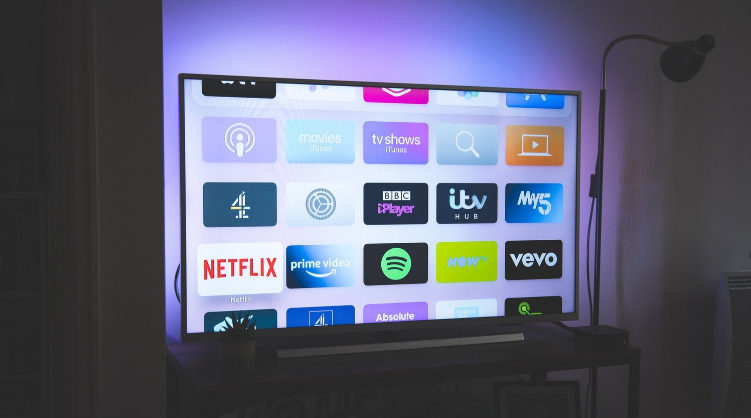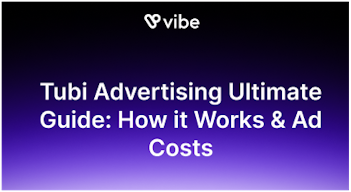5 Best CTV Advertising Examples You Must Check
As streaming platforms continue to dominate, CTV ads have become the go-to for brands wanting to connect with viewers in real-time.
But with so many campaigns out there, it’s tough to know which ones actually drive engagement.
Where do you even start?
And which campaigns actually get results?
And how can your brand tap into that success?
Here’s what you’ll find in this guide:
📺 What is CTV Advertising? A quick rundown on CTV ads and how they differ from traditional TV or digital ads.
🌟 Why Brands Are All In on CTV- Learn why brands jump to CTV for its targeted reach, measurable impact, and cross-device compatibility.
🎬 Top 5 CTV Advertising Examples- A look at successful campaigns from brands like Vibe and Amazon that use CTV ads to engage and inspire.
🚀 Starting Your Own CTV Campaign- Simple steps to help you plan, track, and optimize your CTV ads to make a lasting impact.
By the end, you’ll have a clear picture of what makes these CTV campaigns successful and how to take these ideas into your campaigns.
Let’s break down the CTV strategies worth paying attention to!
What is CTV Advertising?

CTV Advertising (Connected TV Advertising) is digital advertising shown on internet-connected TVs, streaming devices (like Roku or Apple TV), and gaming consoles.
This type of ad targets viewers who watch content on platforms like Netflix, Hulu, or Amazon Prime.
Key Differences from Traditional TV and Digital Ads
- Targeted & Personalized Ads
Traditional TV ads air broadly, reaching anyone tuned in, while CTV ads are targeted based on viewer data like age, location, or interests.
Example: If you frequently watch cooking shows, you might see meal kit ads tailored to your preferences.
- Real-Time Flexibility
Traditional ads are scheduled months in advance, but CTV ads can be updated instantly.
Example: A clothing brand can launch a holiday sale ad immediately on CTV if there’s sudden demand.
- Measurable Results & Interactivity
Unlike traditional ads, CTV ads provide data on who watched, clicked, or interacted. Some ads even allow viewers to take actions like visiting a website.
Lets say, If an ad offers a test drive, you could click directly from your remote to schedule it.
Why CTV Advertising Matters for Brands
CTV advertising helps brands reach people who prefer streaming over regular TV. With CTV, brands can show ads that match the viewer’s interests, location, and viewing habits.
This makes ads feel more relevant and increases viewers' chances of paying attention.
Unlike regular TV ads, CTV ads provide instant data. Brands can see how many people watched the ad, clicked on it, or took action. This feedback helps brands improve their ads quickly, making them more effective.
For example, a fitness brand can show ads to people who watch health shows on streaming apps. These viewers might see ads for workout gear or online fitness classes that better suit their interests.
This way, brands reach the right audience, spend less money, and see better results. CTV advertising lets brands connect with viewers more personally, making it essential in today’s streaming-focused world.
Let’s look at the five best examples of how businesses use CTV to reach more people and achieve strong results.
First, look at how Intellectual Ninjas expanded their client reach with Vibe’s CTV ads.
1. Intellectual Ninjas Expands Client Reach with Vibe’s Programmatic CTV Ads
Intellectual Ninjas, a digital agency, partnered with Vibe in 2024 to expand their client offerings with CTV advertising.
Vibe’s platform helped the agency to launch campaigns with minimum budgets, reaching specific local audiences effectively.
- Used ZIP code targeting to connect clients with relevant viewers, enhancing local impact.
- Reduced costs per view to just 2 cents, compared to 9 cents on other platforms.
- Enabled clear performance insights, boosting client confidence and engagement.
Results:
- 30% Increase in Website Traffic for clients.
- Improved Client Retention as clients saw high returns and stayed for longer campaigns.
Key Takeaway: Vibe’s low entry cost and precise targeting make it an excellent choice for SMBs aiming to reach local audiences through CTV.
Next, let us explore another Vibe example, where they took a different approach with precise targeting of CTV ads.
2. How Abuelo’s Saved 80% on Ad Costs Using Vibe’s CTV Ads
In 2023, Abuelo’s, a family-owned Mexican restaurant, partnered with Vibe to attract more customers to its 14 main locations.
Using Vibe’s CTV ads, they targeted local audiences near their restaurants.
Vibe’s tools helped Abuelo test and personalize ads for each location, making every ad feel relevant to viewers nearby.
Read the complete case study - Here!
Results:
With Vibe’s real-time reports, Abuelo could see what worked and make quick changes, leading to some impressive results:
- 80% lower cost per session
- 26% growth in foot traffic
- Huge reach at just $20 CPM
Key Takeaway: Vibe’s CTV ads help brands like Abuelo’s save money while bringing more customers through the door.
3. StackAdapt – Combining CTV and Data for Gelpro Hits 1000% ROAS with StackAdapt’s Targeting
Gelpro, a top brand in collagen supplements, wanted to stand out and drive national sales.
Partnering with Adcreators, they used StackAdapt’s advanced targeting tools to reach their ideal audience with precision.
By combining lookalike audiences, geotargeting, and pixel tracking, they optimized in real-time, achieving significant reach and cost efficiency.
Results:
- 1000% Return on Ad Spend (ROAS)
- Lowered Cost Per Acquisition (CPA) to $13
- 22% Engagement Rate
Key Takeaway: StackAdapt’s targeted approach helped Gelpro dominate its category, delivering unmatched ROAS and brand visibility.
Next, let's explore how HP used The Trade Desk's unique targeting to make each impression count.
4. HP Expands Reach by 8% with The Trade Desk's Unified ID 2.0
HP aimed to connect with more viewers in a privacy-friendly way as third-party cookies phase out.
By partnering with The Trade Desk, HP used Unified ID 2.0 (UID2) to securely reach new audiences on CTV platforms like Disney and Hulu.
With UID2’s identity-based targeting and The Trade Desk’s DSP, HP expanded its reach while keeping costs low.
Results:
- 8% reach of targeted households
- 23% lower cost per household
- Cost per unique household at $0.16
Key Takeaway: The Trade Desk’s UID2 solution helped HP increase reach while lowering costs, showing the power of CTV to connect with audiences even without third-party cookies.
Next up, let’s see how Vibe helped SIG SAUER leverage CTV advertising for outstanding results.
5. SIG SAUER Boosts ROAS by 1767% with Vibe’s CTV Ads
SIG SAUER, a big name in firearms and optics, wanted to reach more people and get strong results for its binoculars line.
By partnering with Vibe, SIG ran its first nationwide CTV ad campaign, focusing on connecting with the right audience and tracking results closely.
Using Vibe’s retargeting and tracking tools, SIG reached interested viewers, boosting engagement and making every ad dollar count.
Results:
- 1767% Return on Ad Spend (ROAS)
- $25 CPM (Cost per 1,000 Impressions)
- 2% Conversion Rate
- $0.03 Cost per View (CPV)
Key Takeaway: Vibe’s CTV campaign helped SIG SAUER achieve an impressive ROAS, showing how targeted streaming ads can effectively attract new customers.
Key Takeaways from These CTV Advertising Examples
Here’s what worked in these CTV campaigns and how you can use the same ideas:
1. Know Your Audience: Each brand focuses on a specific group of people, aiming their ads based on interests, location, or past actions. Understanding who you want to reach helps you connect with people interested in your product.
2. Make Ads Personal with Data: Ads that feel personal get noticed. These campaigns used data to show the right ads to the right people, such as targeting nearby viewers or reaching out to past visitors.
3. Tell a Story: Stories are easier to remember than plain ads. The TradeDesk showed how storytelling creates a real connection. Think about what simple story your brand can tell—whether it’s solving a problem or adding joy.
4. Reach Across Devices: Today, people move between screens all the time. These campaigns used multiple devices—TVs, phones, and tablets—to keep the brand visible wherever people watch.
5. Track and Adjust: The best campaigns check what’s working and make necessary changes. You might find that certain times or devices work better. Tracking views and engagement helps you improve along the way.
When you make extra effort to connect with your viewers, you turn simple ads into memorable experiences.
How to Get Started with Your Own CTV Ad Campaign
Now let us break down each step to help you launch a campaign that connects with viewers and drives results.
1. Define Your Goal and Audience
Be specific about your goal—more website visits, brand awareness, or direct sales. Knowing your audience is equally important.
For local businesses, tools like Vibe’s geo-targeting can help you focus on nearby viewers, ensuring your ad reaches those most likely to connect.
2. Pick the Right Platform
Choose a platform that matches your budget and needs.
For example, Vibe simplifies targeting and budget management, making it an excellent choice for brands looking to make an impact without overcomplicating things.
3. Create an Eye-Catching, Multi-Device Ad
Keep your ad visually engaging and to the point. A clear message with strong visuals will grab attention.
Extend the reach across TVs, tablets, and smartphones to keep your brand in front of viewers on whichever device they use.
4. Track and Optimize Your Campaign
Monitor views, clicks, and engagement as soon as your ad goes live.
This data helps you see what’s working and guides any adjustments. Simple tweaks—like refining targeting or adjusting timing—can greatly impact results.
With these steps, you’ll be ready to create a CTV campaign that connects with your audience.
Conclusion
To sum it up, CTV ads are a powerful tool for brands aiming to connect with viewers right on their screens—whether it’s the big screen in the living room or a mobile device on the go.
As we’ve explored, successful CTV examples like those run by Vibe, StackAdapt, and The Trade Desk show how targeted, data-driven ads can boost engagement, reduce costs, and make a lasting impact.
With options like personalized targeting, real-time adjustments, and measurable results, CTV advertising lets you go beyond traditional ads, reaching audiences who are genuinely interested in your message.
Whether you’re aiming for brand awareness, customer engagement, or direct sales, CTV ads can help you achieve these goals effectively.
Now, it’s your turn to make CTV work for you. Start small, target smartly, and keep optimizing.
Ready to elevate your brand's reach?
Use Vibe and test out a CTV campaign and see how it can drive results for your business.
Thank you for reading, and see you next time!



